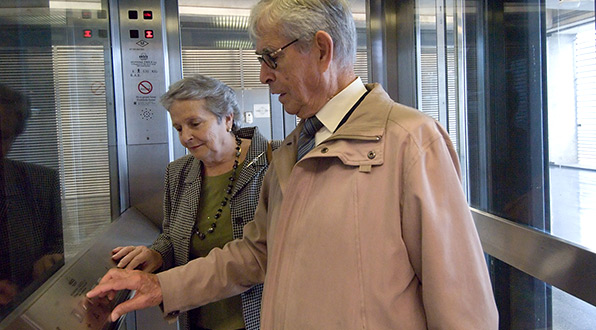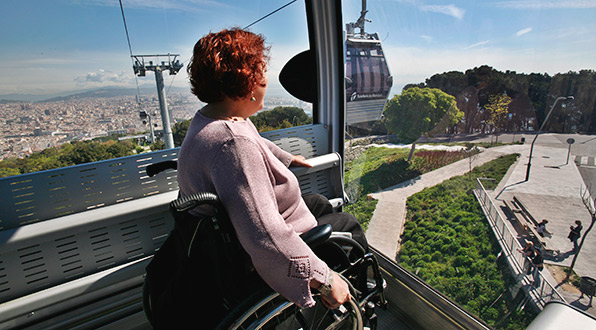Accessible public transport network
Barcelona’s public transport network is already a European benchmark in accessibility. Nevertheless, TMB continues to work to make the whole network more accessible for everyone.
We encourage you to use the information and tools below to plan your journeys around your own personal needs.
Visit Accessibility tools page.
You’ll also find detailed information in the following sections of the website:
Bus network
Since 2007, the bus network has been fully adapted for people with reduced mobility (PRM). The buses in the fleet have reserved seats inside and an access ramp to facilitate boarding, as well as a kneeling system to make entry easier. The new vehicles feature wider seats that enhance comfort.
From 2020, with the incorporation of a new fleet, people with reduced mobility benefit from additional accessibility improvements, such as wider doors and a ramp that adjusts to the door opening. The most notable enhancement is the facing arrangement of the two reserved spaces for wheelchairs, approved scooters, and child strollers; additionally, the safety of wheelchair users is guaranteed with a lateral support bar and adjustable straps.
Efforts have also been made to improve accessibility for people with visual disabilities. The validators inside the vehicles have contrasting signage and braille for easy location, and the vehicle identification number (calca) is located on the second door of the vehicle, with contrasting colors and braille.
To improve infoaccessibility, new screens have been installed to deliver information to everyone, incorporating easy-to-read formats, improved reading transition times, character design, and sound.
You can consult the access regulations for the different personal mobility support items on the Transport Use Regulations page.
You will find more information on Accessibility and reduced mobility page.
Metro network
Since 1992, the construction or renovation of stations in the metro network has been used as an opportunity to improve accessibility conditions by progressively adapting all facilities and infrastructure. Some of these measures include the implementation, across the entire network, of ticket machines with voice navigation systems, tactile paving for visually impaired individuals in many stations, and elevators already available in 153 of the total 165 stations.
We also provide other tools to facilitate the use of our metro network. Since 2012, and updated in 2024, a tactile metro map has been available, accompanied by a Braille and ink guide for people with visual impairments. This guide was developed in collaboration with ONCE Catalunya and can be found at TMB Points.
The trains have been improved over the years, along with the introduction of new ones. The access doors are marked in red and are equipped with visual and acoustic door-closing warnings, as well as next-stop announcements.
With the new trains, the interior of the reserved space has been enhanced (wider and more comfortable), now including a seatbelt, disembarkation request button, and floor signage. Sensors in the reserved area allow the driver to see whether it is occupied by certified wheelchair or mobility scooter users. An induction loop system has been installed in the first and last carriages (at the front and rear of the train).
Communication and information devices have been installed at the height specified by the Accessibility Code, making them accessible to everyone when needed.
Trains also feature screens displaying information about elements of the next station, using easy-to-read and accessible design principles while providing real-time service updates.
Remember that you can check the status of elevators in the metro network on the web page for each station.
All information about stations and connections is also available on the TMB website, as well as on the maps you’ll find throughout the metro network.
You can check the access regulations for the different personal mobility support products on the Transport Use Regulations page.
You will find more information on Accessibility and reduced mobility page.
Tourist transport
- Montjuïc Funicular Railway
- Montjuïc Cable Car
- Barcelona Bus Turístic
- Catalunya Bus Turístic
- Barcelona Night Tour Bus
- Barcelona Christmas Tour
- Tramvia Blau
You will find more information on Accessibility and reduced mobility page.
Customer service
We offer various customer service channels so that you can choose the one that best suits your needs. In each section, you will find the information you need regarding the accessibility of that product or service.
- Help and contact: you can carry out procedures online.
- Face-to-face customer service: we can assisst you at the Punts TMB customer services, at any metro station or on the bus.
- User guide:
- FAQs: basic information on transport, customer service, tickets, regulations of use, etc.



















